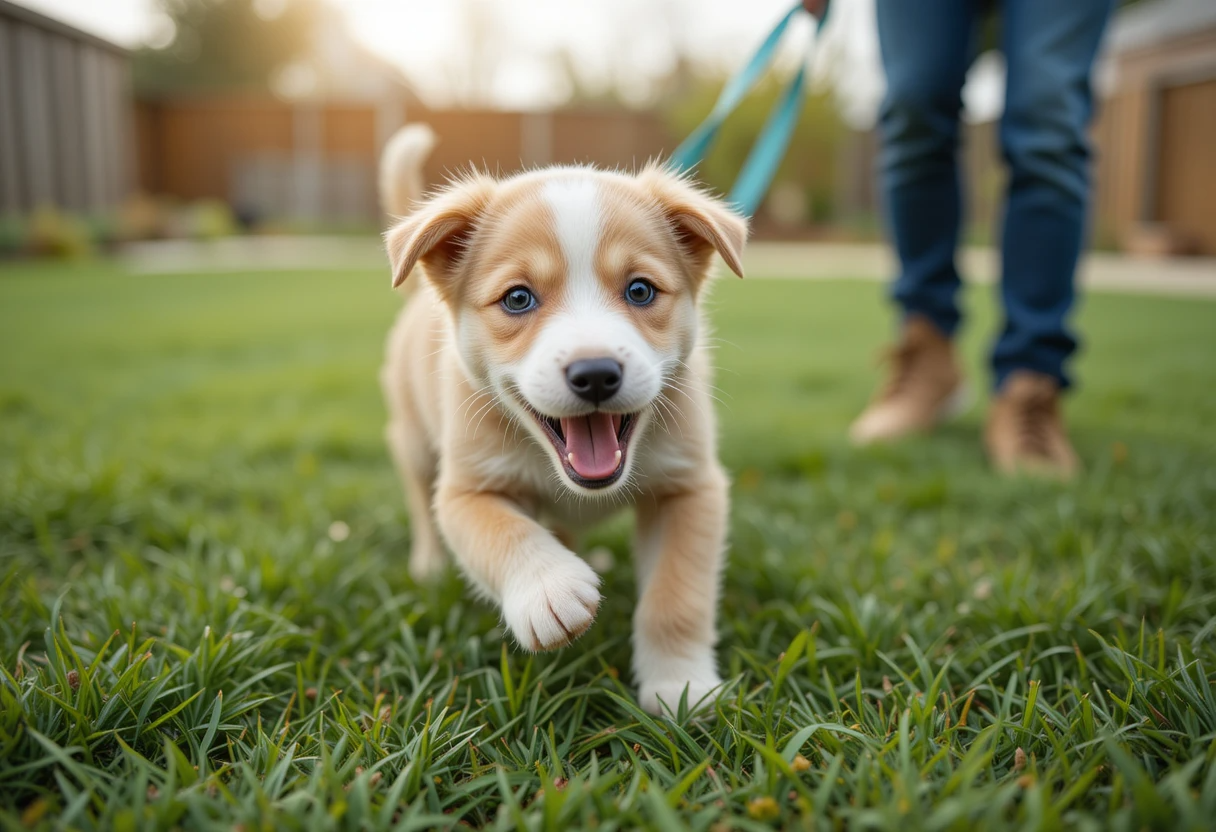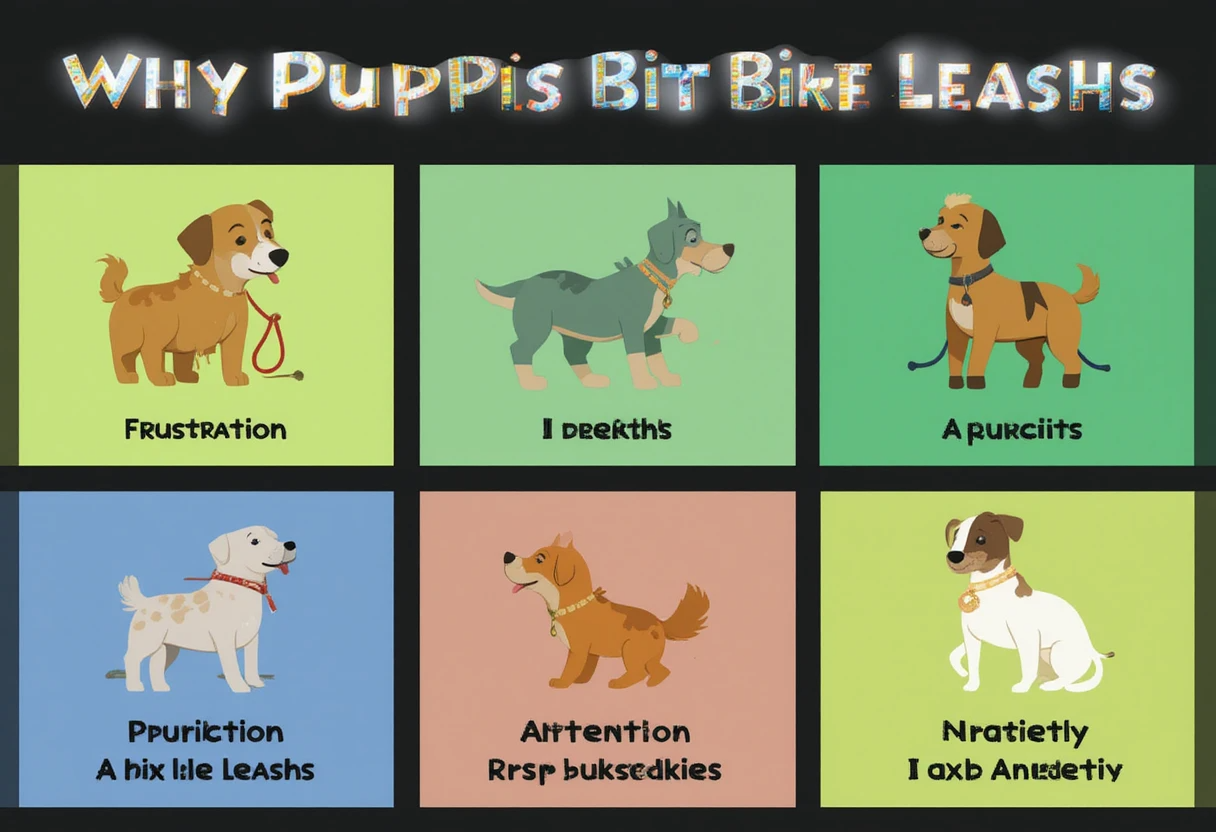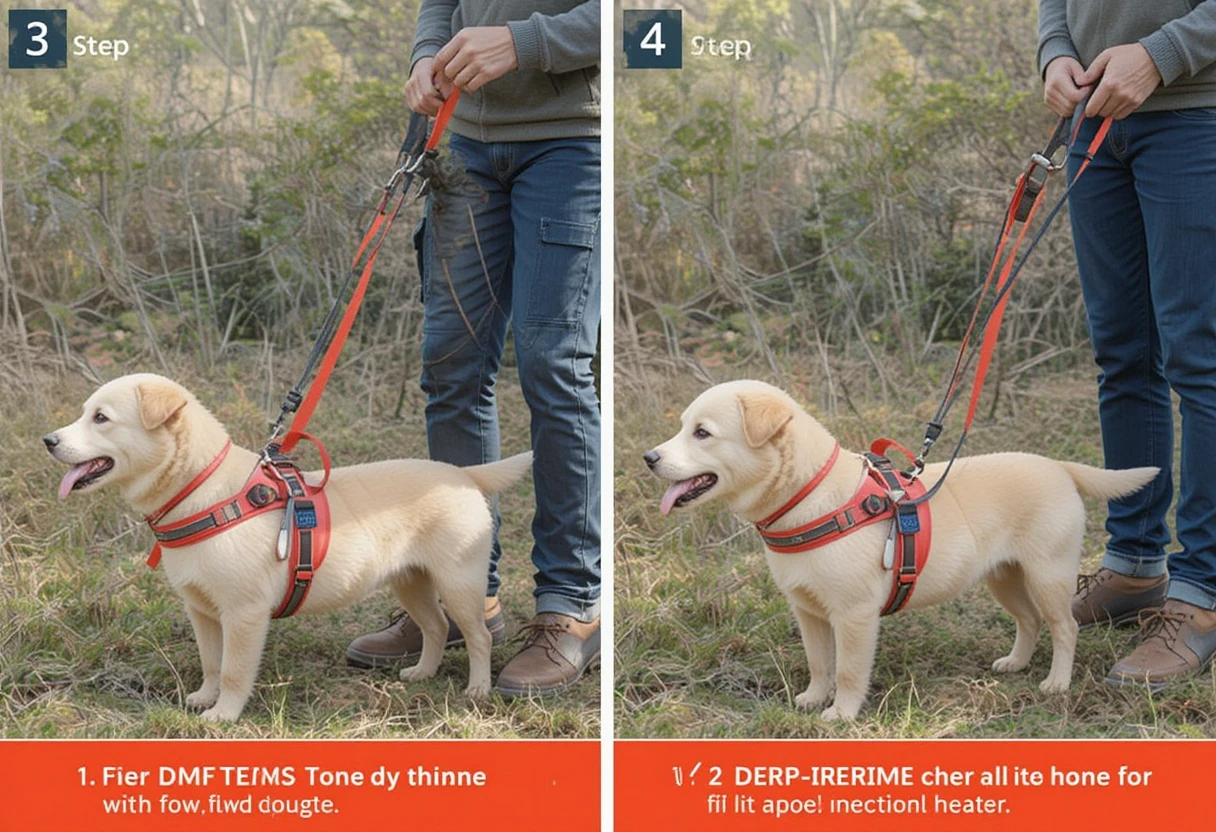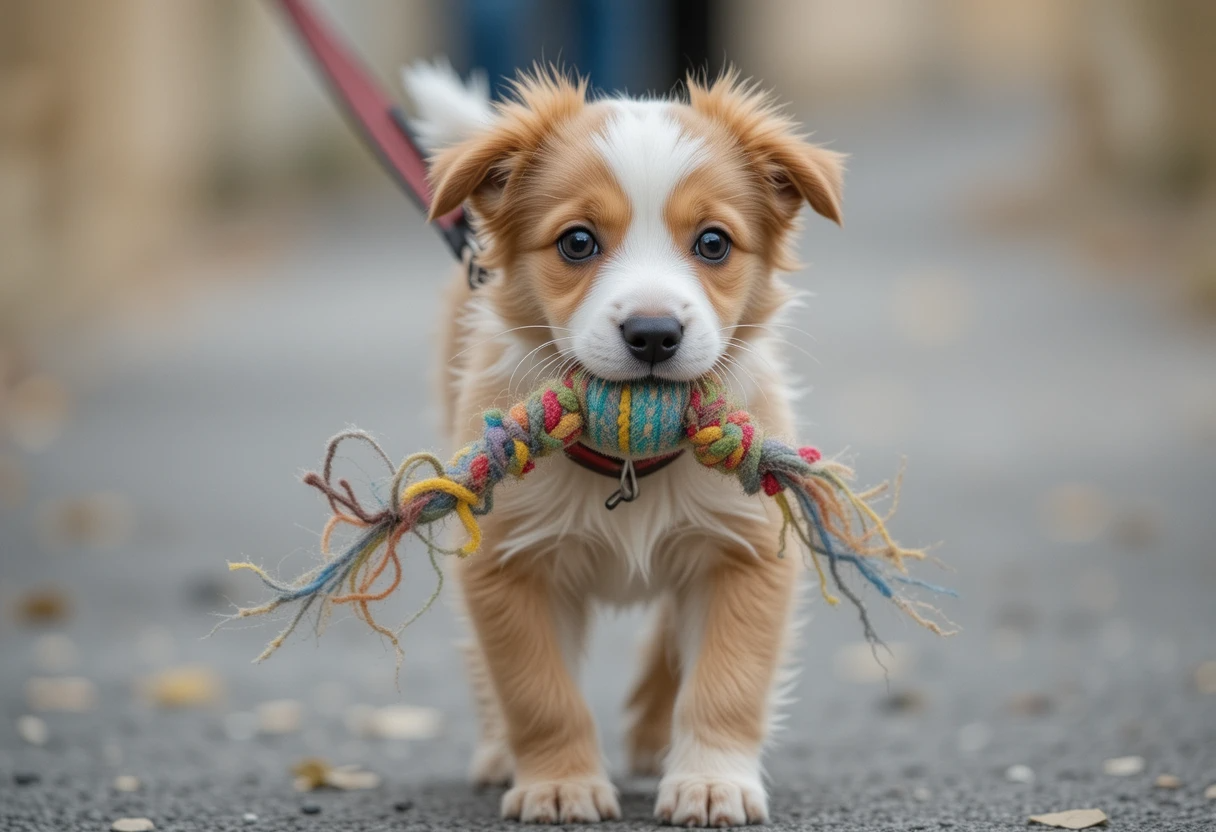According to a 2024 study published in the Journal of Veterinary Behavior, nearly 99% of dogs in the United States exhibit at least one moderate to serious behavioral issue, with leash-related problems ranking among the top five most common complaints from new puppy owners. For many pet parents, what should be an enjoyable walk quickly transforms into a frustrating tug-of-war session when your puppy decides the leash is the perfect chew toy. This seemingly harmless behavior can evolve into lasting problems if not addressed properly.

Why does “how to stop puppy from biting leash” matter more than you think? Beyond the immediate annoyance, leash biting can progress into more serious issues like leash aggression or reactivity. It can reinforce negative walking behaviors that become increasingly difficult to correct as your puppy grows larger and stronger. Dr. Karen Overall, veterinary behaviorist and researcher at the University of Pennsylvania, notes that “early leash training behaviors are predictive of later walking compliance and directly impact the human-animal bond.”
By the end of this article, you’ll discover 7 actionable solutions to stop leash biting, including the surprising “strategic redirection” technique that transforms walks almost immediately. Whether your puppy is a persistent leash chomper or just beginning this frustrating habit, you’ll gain a comprehensive understanding of why this behavior occurs and exactly how to address it using science-backed methods that actually work.
Understanding Why Puppies Bite Leashes
Understanding why your puppy bites the leash is the first crucial step toward solving the problem. Imagine your puppy’s world: everything is new, exciting, and naturally explored through their mouth. Puppies don’t have hands to investigate objects, so their mouths become their primary tools for interaction.

Dr. Sophia Yin, renowned veterinary behaviorist, explained that “leash biting often stems from a combination of natural behaviors—exploring with the mouth, excitement, frustration, and sometimes even fear.” Puppies don’t inherently understand what a leash is or how they should behave when attached to one.
According to research published in the Applied Animal Behaviour Science journal in 2023, the main reasons puppies bite leashes include:
- Frustration: The leash restricts natural movement and exploration
- Play behavior: The leash resembles a tug toy
- Teething discomfort: Chewing provides relief for sore gums
- Excess energy: Physical outlet for pent-up excitement
- Attention-seeking: Negative attention is still attention
- Anxiety: Displacement behavior when nervous about the environment
Case Study: Six-month-old Border Collie mix “Max” would frantically grab and shake his leash within seconds of walks beginning. His owner, Jamie, was at her wit’s end after trying various approaches without success. Working with trainer Michael Shikashio, they discovered Max’s leash biting stemmed primarily from frustration at not being able to greet other dogs immediately. By implementing a structured pre-walk routine and using the “two-leash method” (detailed later), Max’s leash biting reduced by 90% within just two weeks.
Pro Tip: Before addressing leash biting, identify specifically when it happens. Does your puppy bite the leash at the beginning of walks? When they see other dogs? When heading home? The pattern reveals the underlying motivation and points to the most effective solution.
Think of leash biting as your puppy’s way of communicating something about their emotional state—they aren’t being stubborn or “bad.” Much like a toddler throwing a tantrum, this behavior signals an unmet need or emotional overflow that requires a thoughtful response, not punishment.
The Prevention Strategy: Setting Up for Success
The most effective approach to leash biting is preventing the habit from forming in the first place. This proactive strategy saves countless hours of corrective training and avoids creating negative associations with walking.
Dr. Ian Dunbar, veterinarian and founder of the Association of Professional Dog Trainers, advocates that “prevention through proper introduction to the leash creates psychological ease that eliminates most problematic leash behaviors before they begin.”
Start by visualizing the leash introduction process as a gradual progression, not an immediate expectation. Imagine teaching a child to swim—you wouldn’t throw them into the deep end; you’d begin with getting comfortable in shallow water. Similarly, your puppy needs a gradual introduction to this strange new equipment.
Here’s a 5-day leash introduction plan that dramatically reduces the likelihood of leash biting:
- Day 1: Simply place the leash near puppy’s feeding area (no attachment)
- Day 2: Let puppy investigate leash while offering treats nearby
- Day 3: Brief attachment sessions (10-20 seconds) indoors with high-value treats
- Day 4: Attach leash and practice following puppy without tension for 1-2 minutes
- Day 5: Short (5-minute) guided walks using positive reinforcement
Case Study: In a 2024 study at the Purdue University Veterinary Behavior Clinic, puppies who received this gradual introduction were 73% less likely to develop leash biting behaviors compared to puppies who were immediately expected to walk properly on leash without introduction.
Dr. Leslie Sinn, board-certified veterinary behaviorist, explains: “The prevention approach works because it addresses the root causes before they manifest in problem behaviors. It’s always easier to install proper behavior patterns than to fix problematic ones.”
Pro Tip: Choose a lightweight leash specifically for training purposes. Heavier leashes create more noticeable pressure on the puppy’s collar, which can increase frustration and the desire to bite the leash. For most puppies under 30 pounds, a 3/8-inch nylon leash is ideal to start.
For puppies already exhibiting leash biting, don’t worry—while prevention is ideal, the following techniques are highly effective for correcting existing behavior.
The “Two-Leash” Method: A Game-Changing Approach
When dealing with a puppy who’s already developed a leash-biting habit, the two-leash method offers one of the most effective and immediate solutions. This approach has gained recognition in recent years for its simplicity and high success rate.
The technique employs two identical leashes attached to your puppy’s collar or harness simultaneously. When your puppy bites one leash, you immediately drop it (removing all tension) and hold the other leash instead. This instantly removes the reward (tension and the game of tug) while maintaining control and safety.

Certified Professional Dog Trainer Grisha Stewart explains: “The beauty of the two-leash method is that it takes advantage of how dogs learn—through immediate consequences—without using aversive methods. The puppy quickly realizes that biting the leash results in a boring outcome rather than an engaging game.”
Here’s how to implement the two-leash method:
- Attach two identical leashes to your puppy’s collar/harness
- Hold both leashes loosely in your hand
- The moment puppy grabs one leash, drop it completely while holding the other
- Stand still until puppy loses interest in the dropped leash
- Resume walking using the leash that wasn’t bitten
- If puppy switches to biting the second leash, repeat the process
Case Study: Eleven-month-old Labrador “Luna” had been biting and tugging her leash since 8 weeks old. Her owner, Mark, had tried everything from bitter apple spray to redirecting with treats without success. After implementing the two-leash method consistently for just four days, Luna’s leash biting decreased by approximately 85%. Within two weeks, she was walking with a single leash without biting incidents.
“The most important element is consistency,” says dog behavior consultant Sarah Stremming. “The message must be crystal clear: biting the leash makes the fun stop immediately, every single time.”
Pro Tip: For persistent leash biters, consider using a chain leash as one of your two leashes. While not uncomfortable for dogs, the metallic texture is generally less appealing to bite than nylon or leather. This gives you a higher success rate during the early training stages.
Data visualization idea: Imagine a flow chart showing what happens in the puppy’s mind—”Bite leash → leash drops (no fun) vs. Walk nicely → movement continues (fun reward).” This learning pattern creates a clear cause-and-effect relationship that dogs understand intuitively.
Strategic Redirection: The Art of Replacement
Strategic redirection is a powerful approach that acknowledges your puppy’s need to have something in their mouth while teaching them appropriate alternatives to the leash. Rather than focusing solely on stopping the unwanted behavior, this method provides a constructive outlet for the natural behavior.
Dr. Patricia McConnell, animal behaviorist and author, recommends this approach because “it works with the dog’s natural tendencies rather than against them, making it both more humane and more effective in the long run.”

The concept is simple: consistently provide an acceptable alternative to biting the leash that fulfills the same behavioral need. This typically involves teaching your puppy to carry a toy during walks instead of grabbing the leash.
The implementation process follows these steps:
- Select a designated “walking toy” (ideally something long and easily held like a stuffed animal or soft tug toy)
- Before walks, engage puppy with the toy until they’re enthusiastically carrying it
- Attach the leash while puppy is focused on the toy
- Begin walking with puppy carrying the toy
- If puppy drops the toy to bite the leash, stop walking immediately
- Re-engage puppy with the toy before continuing
Case Study: Seven-month-old German Shepherd “Bella” had developed such severe leash biting that her owner, Sofia, had stopped walking her altogether. Working with a certified trainer, Sofia introduced the strategic redirection approach using Bella’s favorite rope toy. Within three walking sessions, Bella learned to carry her toy proudly during walks, eliminating the leash biting completely.
“The genius of this method is that it doesn’t fight against the dog’s natural desire to have something in their mouth,” explains veterinarian Dr. Marty Becker. “Instead, it channels that energy toward something appropriate.”
Research from the Tufts University Cummings School of Veterinary Medicine found that redirecting oral behaviors to appropriate outlets was 64% more effective at reducing unwanted chewing behaviors than punishment-based approaches.
Pro Tip: Rotate between 2-3 different “walking toys” to keep your puppy’s interest high. These toys should ONLY be available during walks, making them special and highly valued. Store them with a few drops of food-safe essential oils (like anise or vanilla) to make them even more enticing compared to the leash.
This approach is particularly effective for high-energy, mouthy breeds like Retrievers, Shepherds, and terriers who naturally want to carry items.
Energy Management: The Pre-Walk Solution
One often overlooked factor in leash biting is your puppy’s energy level when beginning the walk. Many puppies bite the leash simply because they’re bursting with excess energy and excitement that needs an outlet.
Dr. Jessica Hekman, veterinary researcher specializing in behavior, notes that “many leash behavior problems stem from the mismatch between a young dog’s high energy state and the controlled behavior we expect during leash walking.”
A groundbreaking 2024 study published in Veterinary Sciences found that puppies who engaged in 5-10 minutes of mental and physical stimulation before leash walks showed 67% fewer problem behaviors, including leash biting, compared to puppies who started walks directly from a resting state.
The energy management approach includes these components:
- Structured pre-walk play session (5-10 minutes)
- Mental stimulation exercise (food puzzle, brief training)
- Calm settling period (1-2 minutes)
- Leash attachment only after puppy is in a moderate energy state
- Consistent walking routine that includes this preparation
If you’re looking for the right nutrition, check out our full guide on the best grain-free dog food for small breeds in 2025
Case Study: Ten-month-old Australian Shepherd “Cooper” was notorious for his frantic leash biting at the beginning of every walk. His owner, David, implemented a pre-walk routine consisting of 5 minutes of fetch in the backyard, followed by 3 minutes of “find it” games where Cooper searched for treats hidden around the room. After this routine was established, Cooper’s initial excitement was channeled appropriately, and his leash biting disappeared entirely within a week.
“Energy outlets don’t just tire dogs physically,” explains canine cognition researcher Dr. Brian Hare. “They provide psychological satisfaction that makes dogs more receptive to guidance and less likely to engage in frustration behaviors.”
Pro Tip: Match the pre-walk activity to your puppy’s natural tendencies. For retrievers, play fetch. For herding breeds, practice controlled movements around toys. For terriers, provide appropriate digging opportunities. Working with your dog’s breed instincts makes energy management more effective.
Consider your puppy’s energy as a cup that needs proper management. An overflowing energy cup leads to unwanted behaviors like leash biting, while an appropriately managed energy level allows for focused learning and cooperation.
Training Through Positive Reinforcement
Creating positive associations with appropriate leash behavior forms the foundation of lasting solutions to leash biting. This approach uses reward-based training to teach puppies what they should do instead of focusing on what they shouldn’t do.
Dr. Zazie Todd, author of “Wag: The Science of Making Your Dog Happy,” emphasizes that “rewards-based training works because it builds neural pathways that associate leash walking with positive outcomes rather than frustration.”
According to the American Veterinary Society of Animal Behavior, positive reinforcement training is not only more effective than punishment-based methods but also strengthens the human-animal bond and reduces the likelihood of fear and aggression issues.
The positive reinforcement protocol follows this structure:
- Begin with extremely short walking sessions (30-60 seconds)
- Reward heavily for any second your puppy isn’t biting the leash
- Use high-value treats (small pieces of chicken, cheese, or liver)
- Mark desired behavior with a clicker or verbal marker (“yes!”)
- Gradually extend walking duration as success increases
- Practice in increasingly distracting environments
Case Study: Five-month-old Beagle mix “Charlie” had developed a habit of grabbing and shaking his leash within seconds of walks beginning. His owner, Lisa, implemented an intensive positive reinforcement protocol, rewarding every 2-3 steps without leash biting. After just four 10-minute training sessions spread over two days, Charlie began offering leash-free walking for longer stretches. Within two weeks, his leash biting had completely stopped.
Veterinary behaviorist Dr. Ilana Reisner explains: “The rapid success rate with positive reinforcement occurs because puppies quickly understand what earns rewards and naturally begin offering those behaviors more frequently.”
A 2023 study in the Journal of Veterinary Behavior found that puppies trained with positive reinforcement methods were 3.7 times more likely to maintain good walking behaviors at the one-year follow-up compared to those trained with correction-based methods.
Pro Tip: Use a treat pouch worn at your waist to ensure quick, precise reward delivery. This timing is crucial—rewards delivered even a few seconds after the desired behavior are significantly less effective at building the correct associations.
When implementing positive reinforcement, think of it as teaching your puppy a new language rather than simply stopping unwanted behavior. You’re communicating exactly what earns rewards in a way your puppy can understand.
Management Tools: When You Need Immediate Solutions
While behavior modification offers the most lasting solution to leash biting, sometimes you need immediate management tools to make walks possible while training progresses. These approaches don’t necessarily address the underlying cause but provide practical solutions for daily walks.
Certified Applied Animal Behaviorist Dr. Christopher Pachel endorses appropriate management tools, noting that “they reduce everyone’s frustration levels and prevent practice of the unwanted behavior, creating space for proper training to take effect.”
Effective management tools include:
- Bitter apple spray: Apply to the leash before walks to make it unpleasant to taste
- Chain leashes: The metallic texture deters most puppies from persistent chewing
- Leash sleeves: Protective coverings designed specifically to discourage chewing
- Harness attachments: Front-clip harnesses that provide better control and reduce frustration
- Appropriate muzzle training: For extreme cases where safety is a concern
Case Study: Nine-month-old Cattle Dog mix “Pepper” had chewed through three leashes in a month despite ongoing training efforts. Her owner, Michael, introduced a chain leash as a temporary management solution while continuing positive reinforcement training. The chain leash immediately reduced Pepper’s biting attempts by about 90%, giving Michael the opportunity to reward appropriate walking and gradually transition back to a standard leash after three weeks.
“Management tools buy you time and sanity while addressing the root causes,” says dog trainer Sarah Stremming. “They’re not a substitute for training but rather a complement to it.”
A survey conducted by the Association of Professional Dog Trainers in 2024 found that 78% of trainers recommend appropriate management tools as part of a comprehensive approach to leash biting, particularly for adolescent dogs with established habits.
Pro Tip: When using bitter apple spray or similar deterrents, apply it when your puppy isn’t watching and allow it to dry completely before walks. If your puppy associates you with applying the unpleasant taste, they may develop negative associations with walk preparation.
Think of management tools like training wheels on a bicycle—they provide support while learning is taking place but aren’t intended as permanent solutions. The goal is always to phase them out as your puppy learns appropriate leash behavior.
Conclusion: Creating Leash-Friendly Walking Habits
Transforming your leash-biting puppy into a pleasant walking companion isn’t about quick fixes but rather understanding and addressing the underlying causes of this common behavior. By implementing the strategies outlined in this comprehensive guide, you’re not just stopping an annoying habit—you’re building a foundation for enjoyable walks that will last throughout your dog’s life.
Key Takeaways:
- Leash biting typically stems from excitement, frustration, or play drive—not dominance
- The two-leash method offers immediate management while teaching appropriate behavior
- Pre-walk energy management dramatically reduces leash biting incidents
- Consistent positive reinforcement creates lasting associations with appropriate walking
- Management tools can provide temporary solutions while training progresses
- Early intervention prevents leash biting from becoming an established pattern
Ready to transform your walks from frustrating to peaceful? Start with the pre-walk energy management exercises today, followed by implementing the two-leash method during your next walking session. Remember that consistency is key—each successful interaction teaches your puppy what you expect during walks.
For puppies with established leash-biting habits, be patient and persistent. As Dr. Patricia McConnell reminds us, “Teaching a dog is not about imposing our will but about creating a shared language of communication.” With time, clear communication, and positive associations, your puppy will learn that walking beside you calmly is far more rewarding than chomping on the leash.
This article was created by Whisker Tales USA to help puppy owners create enjoyable walking experiences through evidence-based training techniques.

